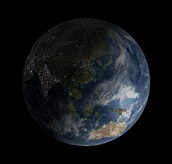ব্যবহারকারী:Runab WMF/bangla test page

Winter solstice is an astronomical phenomenon which marks the shortest day and the longest night of the year. Winter solstice occurs for the Northern Hemisphere in December and for the Southern Hemisphere in June.
The axial tilt of Earth and gyroscopic effects of its daily rotation mean that the two opposite points in the sky to which the Earth's axis of rotation points change very slowly (making a complete circle approximately every 26,000 years). As the Earth follows its orbit around the Sun, the polar hemisphere that faced away from the Sun, experiencing winter, will, in half a year, face towards the Sun and experience summer. This is because the two hemispheres face opposite directions along Earth's axis, and so as one polar hemisphere experiences winter, the other experiences summer.
More evident from high latitudes, a hemisphere's winter solstice occurs on the shortest day and longest night of the year, when the sun's daily maximum elevation in the sky is at its lowest.[১] The winter solstice itself lasts only a moment in time, so other terms are used for the day on which it occurs, such as "midwinter", or the "shortest day". It is often considered the "extreme of winter" (Dongzhi in the Chinese calendar), although in meteorology winter in the Northern Hemisphere spans the entire period of December through February. The seasonal significance of the winter solstice is in the reversal of the gradual lengthening of nights and shortening of days. The earliest sunset and latest sunrise dates differ from winter solstice, however, and these depend on latitude, due to the variation in the solar day throughout the year caused by the Earth's elliptical orbit (see earliest and latest sunrise and sunset).
See also[সম্পাদনা]
References[সম্পাদনা]
- ↑ An Introduction to Physical Science, 12th Ed., James Ship-man, Jerry D.
[[বিষয়শ্রেণী:ধর্মনিরপেক্ষ ছুটির দিন]]
